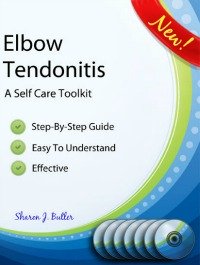Tendonitis Self Care
Tendonitis occurs when there is unnecessary constant stress passing from the muscle through the tendon, irritating it. The key to recovering from tendonitis is to restore those muscles back to their normal loose and relaxed state.
So, how do we accomplish this? Stretching, stretching and more stretching!
Gentle stretching, that is.
Remember that muscle in this condition does not respond to stretching in the same way that a perfectly normal muscle would. It is important to remember this when you are stretching.
If you are experiencing symptoms of wrist tendonitis, then you should stretch all the muscles that cross the wrist.
If you are experiencing symptoms of elbow tendonitis, then you should stretch all the muscles that cross the elbow.
Go slowly, pay attention to the sensations you feel as you stretch and make sure that your stretching is never painful.
Stretches that incorporate a twisting motion can be especially helpful for restoring muscles and tendons back to their normal state when dealing with Tendonitis.
Reversing tendonitis is greatly related to the condition of the fascia that wraps and permeates through muscle and becomes tendon. As a result, this tissue needs to be adequately hydrated to function more normally. Make sure that you are drinking plenty of water to lubricate those layers of fascia.
It is equally important to figure out how you use your muscles in ways that create physical stress.
Pay attention to how you hold your hands when they are not doing anything, how hard you grip objects, how much tension you hold in your hands and fingers. Do you keep your elbows bent for no reason? Each of these habits can contribute to stress in muscle and fascia, leading to Tendonitis.
Evaluate how you use your muscles to see if you can identify sources of stress that affect your muscles and tendons.
Unconscious habits contribute significantly to the development of Tendonitis. If you are in the habit of holding your arms slightly forward of the mid line of your body when using the computer, reading a book, carrying things in front of your body, etc., the biceps muscle is forced to remain in contraction to allow these patterns to continue.
Constant contraction of the biceps can lead to the development of Tendonitis in the elbow as the biceps muscle crosses that joint.
Similarly, chronically holding the wrist in a constant bend, like when bending the wrist to rest it on a desk or table, can also lead to chronic contraction of the muscles related to wrist movement. Their tendons become irritated the longer they are held in a chronic state if contraction.
To learn more about Tendonitis, visit the following sections:
Tendonitis Anatomy
Tendonitis Symptoms
Combining all these factors into a consistent self care program will yield the best results.
Click the block below that most closely matches your injury for more information and to find the Toolkit we offer to help you in your recovery.








